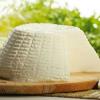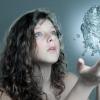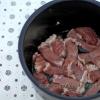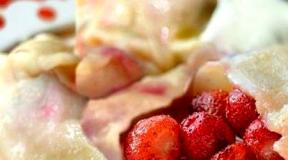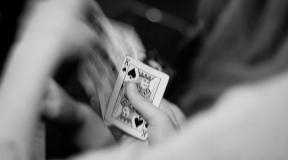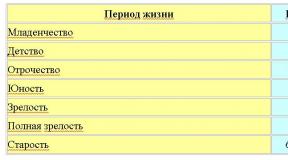Multiple reflection. A candle between two mirrors: mysticism and physics Observing a burning candle
The number of candle reflections changes.
Rice. 23. Multiple reflection of a candle in two mirrors
Suggest possibilities for using multiple reflections.
Based on your observations, draw a conclusion about the physical and chemical phenomena that accompany the burning of a candle.
2. Monitoring the germination of bean seeds
This work lasts several days and can be done by two people or in groups.
Goal of the work: observe the external changes of beans over time and changes in their mass.
Equipment and reagents: saucer or Petri dish, gauze, 2-3 bean seeds, water, scales (technical or electronic).
Progress
Place gauze rolled up in several layers in a Petri dish or saucer, pour in enough water to cover the gauze. Place bean seeds on cheesecloth, after weighing each one. Leave the saucers with beans on the windowsill in the science classroom.
Monitor the appearance of the seeds daily. Record the changes that occur with them in a notebook, weigh them daily (after blotting them with a paper napkin) and also write the results in the notebook. When the beans germinate and small wrinkled leaves appear on the sprout, the observation can be completed.
Draw the seeds at the beginning of the experiment and at the end.
When was the change in bean seed mass most intense?
Plot a graph of the mass of germinating bean seeds versus time.
Draw a conclusion about the reasons for the change in the mass of beans.
3. Observation of changes in the state of ice when heated
Goal of the work: observe the phenomenon of ice melting, describe the change in the state of ice depending on temperature, draw conclusions about the change in ice temperature during melting.
Equipment and materials: ice, thermometer, glass glass with a capacity of 50-100 ml, cloth.
Progress
Crush the ice well by wrapping it in a cloth. Place crushed ice in a glass glass.
Measure the temperature of the ice and record the result in Table 4.
Measure the temperature of the ice every 3–5 minutes and record the state of aggregation of the water, recording the data in a table.
Table 4
Plot a graph of the temperature of water in different states of aggregation versus time.
Chapter 2. Megaworld
§ 8. Man and the Universe
1. Show with examples how ideas about the world system changed from ancient times to the 17th century.
2. Name the names of scientists of the 16th–17th centuries, whose contribution to astronomy cannot be overestimated.
3. Give a brief description of the achievements of Russian science in the field of astronautics.
4. Remember the names of poets, artists, writers, composers, directors whose works about space, stars, real and imaginary journeys to distant planets stuck in your mind.
The attraction of distant stars
Remember how on a cloudless summer night you, throwing your head back, could not take your eyes off the mesmerizing starry sky. How many artists, poets, writers were inspired to create great works by the twinkling of distant stars, unknown worlds (Fig. 24). How many travelers have the stars shown the right path to their goal, how many lost travelers have they helped find their way home.
I am the son of the Earth, a child of a small planet,
Lost in the space of the world,
Under the burden of centuries long tired,
Dreaming fruitlessly about something else.
V. Bryusov
Rice. 24. V. Van Gogh. Starry night over the Rhone. 1888
Perhaps there is nothing more frighteningly attractive, endlessly distant, accessible and inaccessible than the megaworlds, in the depths of which a great miracle was born - a flickering speck of dust called Earth. You should have an idea of what a galaxy, star clusters, stars, black holes, planets, comets and other celestial bodies are, and know modern ideas about the structure and evolution of the Universe. You will learn this and much more in this chapter.
Constellations twinkle in the cosmic darkness,
They shine temptingly and clearly,
But people are used to living on earth,
And this habit is wonderful.
V. Soloukhin Natural philosophy about the earth and the universe
The question of what the Universe is has worried people since ancient times. No one can say for sure when one of the most ancient sciences, astronomy, was born.
Our ancestors, being largely dependent on natural forces, deified celestial bodies - the Sun, Moon, stars. Myths were made about them
Municipal educational institution
Secondary school No. 21
The magic of mirrors
(research work)
Supervisor:
Belgorod, 2011
Research
"The Magic of Mirrors"
How it all began? When I was little, I often looked in the mirror and saw myself in it. I couldn’t understand and was very surprised why I was either alone there, or there were many of me standing facing myself. Sometimes I even looked behind the mirror, thinking that behind it was someone very similar to me. Since childhood, I have been very interested in why this happens, as if there is some kind of magic in the mirror.
For my research I chose a topic"The Magic of Mirrors"
Relevance: The properties of mirrors are being studied to this day, scientists are discovering new facts. Devices with mirrors are used everywhere these days. The unusual properties of mirrors are a hot topic.
Hypothesis: Let's assume that mirrors have magical powers.
We have set ourselves the following tasks:
1. Find out in which country and when the mirror appeared;
2. Study the technology of making mirrors and their application;
3. Conduct experiments with mirrors and get acquainted with their properties;
4. Learn interesting facts about mirrors;
5. Find out whether mirrors have magical powers.
Object of study: mirror.
Subject of study: magical properties of mirrors.
To investigate this problem we:
1. Read encyclopedic articles;
2. Read articles in newspapers and periodicals;
3. We looked for information on the Internet;
4. We visited a mirror store;
5. Fortune telling using mirrors.
In what country and when did the mirror appear?
The history of the mirror began already in the third millennium BC. The earliest metal mirrors were almost always round in shape.
The first glass mirrors were created by the Romans in the 1st century AD. With the beginning of the Middle Ages, glass mirrors completely disappeared: almost simultaneously, all religious concessions believed that the devil himself was looking at the world through mirror glass.
Glass mirrors reappeared only in the 13th century. But they were... concave. The manufacturing technology of that time did not know a way to “glue” a tin backing to a flat piece of glass. Therefore, molten tin was simply poured into a glass flask and then broken into pieces. Only three centuries later did the masters of Venice figure out how to cover a flat surface with tin. Gold and bronze were added to the reflective compositions, so all objects in the mirror looked more beautiful than in reality. The cost of one Venetian mirror was equal to the cost of a small sea vessel. In 1500 in France, an ordinary flat mirror measuring 120 by 80 centimeters cost two and a half times more than a Raphael painting.
How a mirror is made.
Currently, mirror production consists of the following stages:
1)glass cutting
2) decorative processing of the edges of the workpiece
3) applying a thin film of metal (reflective coating) to the back wall of the glass is the most critical operation. Then a protective layer of copper or special bonding chemicals is applied, followed by two layers of protective paint that prevents corrosion.
What if mirrors have magical properties?
1 . My dad, mom and I love to travel to different cities. We especially like to visit palaces and castles. I was amazed that in the halls where balls used to take place there were a lot of mirrors. Why so many? After all, in order to straighten your hair or look at yourself, one mirror is enough. It turns out that mirrors are needed in order to increase illumination and multiply burning candles.
Experience 1: I'll make a mirrored corridor and bring candles. The lighting increased.
Therefore, all palaces have halls of mirrors for large receptions.
Experience 2. Mirrors can reflect not only images, but also sound. That's why there are many mirrors in ancient castles. They created an echo - a reflection of sound and amplified musical sounds during the holidays.
Experience 3. There are several mirrors in our houses. There aren't many of them. Why?
It is impossible to live in a mirrored room. There was a Spanish torture: they put a person in a mirror room - a box, where there was nothing except a lamp and a person! Unable to bear his reflections, the man went crazy.
Conclusion : Mirrors have the properties of reflecting sound, light, and the opposite world.
Write three words on a piece of paper, one under the other: FRAME, LUM and SLEEP. Place this piece of paper perpendicular to the mirror and try to read the reflections of these words in the mirror. The word FRAME is unreadable, the LUM remained what it was, and the DREAM turned into a NOSE!
The mirror reverses the sequence of letters, and you should read the reflection of words in the mirror not from left to right, as we are used to, but vice versa. But we read, following our long-term habit! And the words LUM and SLEEP are very interesting in themselves. Lump can be read unambiguously both from left to right and vice versa! And the word DREAM in reverse reading turns into NOSE! Here's proof of how a mirror works!
After these experiments it is easy to understand secret code of Leonardo da Vinci. His notes could only be read with the help of a mirror! But in order for the text to be easy to read, it still had to be written topsy-turvy!
The man in the mirror.
Let's figure out who is there, visible in the mirror? My reflection or not mine?
Just look carefully at yourself in the mirror!
The hand clutching the pencil is for some reason in the left hand!
Let's put our hand on our hearts.
Oh horror, the one behind the mirror has it on the right!
And the mole jumped from one cheek to the other!
It’s clearly not me in the mirror, but my antipode! And I don’t think that’s how passers-by on the street see me. I don't look like that at all!

How can you make sure that you see exactly your unconverted image in the mirror?
If two flat mirrors are placed vertically at right angles to each other, then you will see a “straight”, uninverted image of the object. For example, an ordinary mirror gives an image of a person whose heart is on the right. In the corner mirror of the image, the heart will be, as expected, on the left side! You just need to stand in front of the mirror correctly!
The vertical axis of symmetry of your face should lie in a plane bisecting the angle between the mirrors. Having assembled the mirrors, move them: if the angle of the solution is straight, you should see a complete reflection of your face.

Experience 7
Multiple reflection
And now I can answer why there are so many of me in mirrors?
To conduct the experiment we will need:
- two mirrors
- protractor
- scotch
- items
Work plan: 1. Secure it with tape on the back of the mirror.
2. Place a lit candle in the center of the protractor.
3. Place the mirrors on the protractor so that they form an angle of 180 degrees. We can observe one reflection of a candle in the mirrors.
4. Reduce the angle between the mirrors.

Conclusion: As the angle between the mirrors decreases, the number of reflections of the candle in them increases.
The magic of mirrors.
Since the 16th century, mirrors have once again regained their reputation as the most mysterious and most magical objects ever created by man. In 1900, the so-called Palace of Illusions and the Palace of Mirages enjoyed great success at the Paris World Exhibition. In the Palace of Illusions, each wall of the large hexagonal hall was a huge polished mirror. The viewer inside this hall saw himself lost among 468 of his doubles. And in the Palace of Mirages, in the same hall of mirrors, a painting was depicted in each corner. Parts of the mirror with images were “flipped” using hidden mechanisms. The viewer found himself either in an extraordinary tropical forest, or among the endless halls of the Arabic style, or in a huge Indian temple. The “tricks” of a hundred years ago have now been adopted by the famous magician David Copperfield. His famous trick with the disappearing carriage owes entirely to the Palace of Mirages.
Now let's look at some fortune telling using mirrors.
Mirror magic was also used for fortune telling.
Fortune telling on mirrors was brought to us from abroad along with the mirror in its modern form around the end of the 15th century.
The most active time for fortune telling in the old days was from January 7 to January 19. These twelve holiday days between Christmas (January 7) and Epiphany (January 19) were called Christmastide.
Let me give you an example of fortune telling:
1) A small mirror is doused with water and taken out into the cold at exactly midnight. After some time, when the mirror freezes and different patterns form on its surface, you need to bring it into the house and immediately tell fortunes from the frozen surface.
If circles are found on the mirror, then you will live in abundance for a year; If you look at the outline of a fir branch, it means you have a lot of work ahead of you. Squares predict difficulties in life, and triangles are harbingers of great success and luck in any business.
After fortune telling, I realized: the mirror itself does not have magical properties. Man has them. And a mirror is only a means that helps strengthen the information of the subconscious and make it accessible to perception.
Conclusion: We do not believe in the magical power of mirrors; ignorant and uneducated people attribute supernatural properties to them. After all, the laws of optics explain all mirror miracles from a scientific point of view. Consequently, our hypothesis was confirmed. The beautiful fairy tale about mirrors is just a fantasy. And this was confirmed by our experiments.
Geometric optics is based on the idea of rectilinear propagation of light. The main role in it is played by the concept of a light beam. In wave optics, the light beam coincides with the direction of the normal to the wave front, and in corpuscular optics, with the trajectory of the particle. In the case of a point source in a homogeneous medium, the light rays are straight lines emerging from the source in all directions. At the interfaces between homogeneous media, the direction of light rays may change due to reflection or refraction, but in each of the media they remain straight. Also, in accordance with experience, it is accepted that in this case the direction of the light rays does not depend on the intensity of the light.
Reflection.
When light is reflected from a polished flat surface, the angle of incidence (measured from the normal to the surface) is equal to the angle of reflection (Figure 1), with the reflected ray, the normal ray, and the incident ray all lying in the same plane. If a light beam falls on a flat mirror, then upon reflection the shape of the beam does not change; it just spreads in a different direction. Therefore, when looking into a mirror, one can see an image of a light source (or an illuminated object), and the image appears to be the same as the original object, but located behind the mirror at a distance equal to the distance from the object to the mirror. The straight line passing through the point object and its image is perpendicular to the mirror.
Multiple reflection.
When two mirrors face each other, the image appearing in one of them is reflected in the other, and a whole series of images is obtained, the number of which depends on the relative position of the mirrors. In the case of two parallel mirrors, when an object is placed between them (Fig. 2, A), an infinite sequence of images is obtained located on a straight line perpendicular to both mirrors. Part of this sequence can be seen if the mirrors are spaced far enough apart to allow a view from the side. If two plane mirrors form a right angle, then each of the two primary images is reflected in the second mirror, but the secondary images coincide, so that the result is only three images (Fig. 2, b). With smaller angles between the mirrors, a larger number of images can be obtained; they are all located on a circle passing through the object, with the center at a point on the line of intersection of the mirrors. The images produced by flat mirrors are always imaginary - they are not formed by real light beams and therefore cannot be obtained on the screen.
Reflection from curved surfaces.
Reflection from curved surfaces occurs according to the same laws as from straight ones, and the normal at the point of reflection is perpendicular to the tangent plane at this point. The simplest, but most important case is reflection from spherical surfaces. In this case, the normals coincide with the radii. There are two options here:
1. Concave mirrors: light falls from inside onto the surface of a sphere. When a beam of parallel rays falls on a concave mirror (Fig. 3, A), the reflected rays intersect at a point located half the distance between the mirror and its center of curvature. This point is called the focus of the mirror, and the distance between the mirror and this point is the focal length. Distance s from object to mirror, distance sў from mirror to image and focal length f related by the formula
1/f = (1/s) + (1/sў ),
where all quantities should be considered positive if they are measured to the left of the mirror, as in Fig. 4, A. When an object is at a distance greater than the focal distance, a true image is formed, but when the distance s less than focal length, image distance sў becomes negative. In this case, the image is formed behind the mirror and is virtual.
2. Convex mirrors: light falls from outside onto the surface of a sphere. In this case, after reflection from the mirror, a diverging beam of rays is always obtained (Fig. 3, b), and the image formed behind the mirror is always virtual. The position of the images can be determined using the same formula, taking in it the focal length with a minus sign.
In Fig. 4, A a concave mirror is shown. On the left, an object with a height of h. The radius of the spherical mirror is R, and the focal length f = R/2. In this example the distance s from mirror to object more R. The image can be constructed graphically if, out of an infinitely large number of light rays, we consider three emanating from the top of the object. A ray parallel to the main optical axis will pass through the focus after reflection from the mirror. The second ray hitting the center of the mirror will be reflected in such a way that the incident and reflected rays form equal angles with the main axis. The intersection of these reflected rays will give an image of the top point of the object, and a complete image of the object can be obtained if a perpendicular is lowered from this point hў to the main optical axis. To check, you can follow the course of the third ray going through the center of curvature of the mirror and reflecting back from it along the same path. As can be seen from the figure, it will also pass through the intersection point of the first two reflected rays. The image in this case will be real (it is formed by real light beams), inverted and reduced.
The same mirror is shown in Fig. 4, b, but the distance to the object is less than the focal length. In this case, after reflection, the rays form a diverging beam, and their continuations intersect at a point that can be considered as the source from which the entire beam emerges. The image will be virtual, enlarged and upright. The case presented in Fig. 4, b, corresponds to a concave shaving mirror if the object (face) is located within the focal length.
Refraction.
When light passes through the interface between two transparent media, such as air and glass, the angle of refraction (between the ray in the second medium and the normal) is less than the angle of incidence (between the incident ray and the same normal) if the light passes from air into glass (Fig. 5), and greater than the angle of incidence if the light passes from glass to air. Refraction obeys Snell's law, according to which the incident and refracted rays and the normal drawn through the point at which the light intersects the boundary of the media lie in the same plane, and the angle of incidence i and refraction angle r, measured from the normal, are related by the relation n= sin i/sin r, Where n– the relative refractive index of the media, equal to the ratio of the speeds of light in these two media (the speed of light in glass is less than in air).
If light passes through a plane-parallel glass plate, then, since this double refraction is symmetrical, the emerging ray is parallel to the incident one. If the light does not fall normal to the plate, then the emerging beam will be displaced relative to the incident beam by a distance depending on the angle of incidence, the thickness of the plate and the refractive index. If a beam of light passes through a prism (Fig. 6), then the direction of the emerging beam changes. In addition, the refractive index of glass is not the same for different wavelengths: it is higher for violet light than for red light. Therefore, when white light passes through a prism, its color components are deflected to varying degrees, decomposing into a spectrum. Red light deviates the least, followed by orange, yellow, green, cyan, indigo and finally violet. The dependence of the refractive index on the wavelength of radiation is called dispersion. Dispersion, like the refractive index, strongly depends on the properties of the material. Angular deviation D(Fig. 6) is minimal when the beam moves symmetrically through the prism, when the angle of incidence of the beam at the entrance to the prism is equal to the angle at which this beam exits the prism. This angle is called the angle of minimum deviation. For a prism with a refracting angle A(apex angle) and relative refractive index n the ratio is valid n= sin[( A + D)/2]sin( A/2), which determines the angle of minimum deviation.
Critical angle.
When a beam of light passes from an optically denser medium, such as glass, to a less dense medium, such as air, the angle of refraction is greater than the angle of incidence (Fig. 7). At a certain value of the angle of incidence, which is called critical, the refracted beam will slide along the interface, still remaining in the second medium. When the angle of incidence exceeds the critical one, there will be no more refracted ray, and the light will be completely reflected back into the first medium. This phenomenon is called total internal reflection. Since at an angle of incidence equal to the critical angle, the angle of refraction is equal to 90° (sin r= 1), critical angle C, at which total internal reflection begins, is given by the relation sin C = 1/n, Where n– relative refractive index.
Lenses.
When refraction occurs on curved surfaces, Snell's law also applies, as does the law of reflection. Again, the most important case is the case of refraction on a spherical surface. Let's look at Fig. 8, A. The straight line drawn through the vertex of the spherical segment and the center of curvature is called the principal axis. A ray of light traveling along the main axis falls on the glass along the normal and therefore passes without changing direction, but other rays parallel to it fall on the surface at different angles to the normal, increasing with distance from the main axis. Therefore, the refraction will be greater for distant rays, but all the rays of such a parallel beam running parallel to the main axis will intersect it at a point called the main focus. The distance from this point to the top of the surface is called the focal length. If a beam of the same parallel rays falls on a concave surface, then after refraction the beam becomes divergent, and the extensions of these rays intersect at a point called the imaginary focus (Fig. 8, b). The distance from this point to the vertex is also called the focal length, but it is assigned a minus sign.
A body of glass or other optical material delimited by two surfaces whose radii of curvature and focal lengths are large relative to other dimensions is called a thin lens. Of the six lenses shown in Fig. 9, the first three are collecting, and the remaining three are scattering. The focal length of a thin lens can be calculated if the radii of curvature and the refractive index of the material are known. The corresponding formula is
Where R 1 and R 2 – radii of curvature of surfaces, which in the case of a biconvex lens (Fig. 10) are considered positive, and in the case of a biconcave lens – negative.
The image position for a given object can be calculated using a simple formula, taking into account some conventions shown in Fig. 10. The object is placed to the left of the lens, and its center is considered the origin from which all distances along the main axis are measured. The area to the left of the lens is called object space, and the area to the right is called image space. In this case, the distance to the object in object space and the distance to the image in image space are considered positive. All distances shown in Fig. 10, positive.
In this case, if f- focal length, s is the distance to the object, and sў – distance to the image, the thin lens formula will be written in the form
1/f = (1/s) + (1/sў )
The formula is also applicable for concave lenses, if we consider the focal length to be negative. Note that since light rays are reversible (i.e., they will follow the same path if their direction is reversed), the object and image can be swapped, provided that the image is valid. Pairs of such points are called conjugate points of the system.
Guided by Fig. 10, it is also possible to construct an image of points located outside the main axis. A flat object perpendicular to the axis will also correspond to a flat image perpendicular to the axis, provided that the dimensions of the object are small compared to the focal length. Rays passing through the center of the lens are not deflected, and rays parallel to the main axis intersect at the focus lying on this axis. Object in Fig. 10 is represented by an arrow h left. The image of the top point of the object is located at the intersection point of many rays emanating from it, of which it is enough to choose two: a ray parallel to the main axis, which then passes through the focus, and a ray passing through the center of the lens, which does not change its direction while passing through the lens. Having thus obtained the top point of the image, it is enough to lower the perpendicular to the main axis to obtain the entire image, the height of which will be denoted by hў. In the case shown in Fig. 10, we have a real, inverted and reduced image. From the similarity relations of triangles it is easy to find the relation m image height to object height, which is called magnification:
m = hў / h = sў / s.
Lens combinations.
When we are talking about a system of several lenses, the position of the final image is determined by sequentially applying a formula known to us to each lens, taking into account signs. Such a system can be replaced by a single lens with an “equivalent” focal length. In the case of two spaced apart a simple lenses with a common principal axis and focal lengths f 1 and f 2 equivalent focal length F is given by the formula
If both lenses are combined, i.e. think that a® 0, then we get The reciprocal of the focal length (taking into account the sign) is called optical power. If the focal length is measured in meters, then the corresponding optical power is expressed in dioptres. As is clear from the last formula, the optical power of a system of closely spaced thin lenses is equal to the sum of the optical powers of individual lenses.
Thick lens.
The case of a lens or lens system whose thickness is comparable to the focal length is quite complex, requires cumbersome calculations and is not considered here.
Lens errors.
When light from a point source passes through a lens, all the rays do not actually intersect at a single point - the focus. Some rays are deflected to varying degrees, depending on the type of lens. Such deviations, called aberrations, are due to various reasons. One of the most significant is chromatic aberration. It is due to the dispersion of the lens material. The focal length of a lens is determined by its refractive index, and its dependence on the wavelength of incident light results in each color component of white light having its own focus at different points on the main axis, as shown in Fig. 11. There are two types of chromatic aberration: longitudinal - when the foci from red to violet are distributed along the main axis, as in Fig. 11, and transverse - when the magnification changes depending on the wavelength and colored contours appear on the image. Correction of chromatic aberration is achieved by using two or more lenses made of different glasses with different types of dispersion. The simplest example is a telephoto lens. It consists of two lenses: a converging lens made of crown and a diffuse lens made of flint, the dispersion of which is much greater. Thus, the dispersion of the converging lens is compensated by the dispersion of the weaker diverging lens. The result is a collecting system called an achromat. In this combination, chromatic aberration is corrected for only two wavelengths, and a small coloration, called the secondary spectrum, still remains.
Geometric aberrations.
The above formulas for thin lenses, strictly speaking, are the first approximation, although very satisfactory for practical needs, when the rays in the system pass near the axis. A more detailed analysis leads to the so-called third-order theory, which considers five different types of aberrations for monochromatic light. The first of them is spherical, when the rays farthest from the axis intersect after passing the lens closer to it than those closest to the axis (Fig. 12). Correction of this aberration is achieved by using multi-lens systems with lenses of different radii. The second type of aberration is coma, which occurs when the rays form a small angle with the axis. The difference in focal lengths for beam rays passing through different zones of the lens determines the different transverse magnification (Fig. 13). Therefore, the image of a point source takes on the appearance of a comet's tail due to images shifted away from the focus, formed by the peripheral zones of the lens.
The third type of aberration, also related to the image of points offset from the axis, is astigmatism. Rays from a point incident on the lens in different planes passing through the axis of the system form images at different distances from the center of the lens. The image of a point is obtained either in the form of a horizontal segment, or in the form of a vertical segment, or in the form of an elliptical spot, depending on the distance to the lens.
Even if the three aberrations considered are corrected, curvature of the image plane and distortion will remain. Curvature of the image plane is very undesirable in photography, since the surface of the photographic film must be flat. Distortion distorts the shape of an object. The two main types of distortion, pincushion and barrel, are shown in Fig. 14, where the object is a square. A little distortion is tolerable in most lens systems, but is extremely undesirable in aerial photography lenses.
Formulas for aberrations of various types are too complex for a complete calculation of aberration-free systems, although they allow approximate estimates to be made in individual cases. They have to be supplemented by a numerical calculation of the path of rays in each specific system.
WAVE OPTICS
Wave optics deals with optical phenomena caused by the wave properties of light.
Wave properties.
The wave theory of light in its most complete and rigorous form is based on Maxwell's equations, which are partial differential equations derived from the fundamental laws of electromagnetism. In it, light is considered as an electromagnetic wave, the electric and magnetic components of the field of which oscillate in mutually perpendicular directions and perpendicular to the direction of propagation of the wave. Fortunately, in most cases, a simplified theory based on Huygens' principle is sufficient to describe the wave properties of light. According to this principle, each point on a given wavefront can be considered a source of spherical waves, and the envelope of all such spherical waves produces a new wavefront.
Interference.
Interference was first demonstrated in 1801 by T. Jung in an experiment, the diagram of which is presented in Fig. 15. A slit is placed in front of the light source, and at some distance from it there are two more slits, symmetrically located. When placed further away, the screen shows alternating light and dark stripes. Their occurrence is explained as follows. Crevices S 1 and S 2 on which light falls from the slit S, play the role of two new sources emitting light in all directions. Whether a certain point on the screen will be light or dark depends on the phase in which light waves from the slits arrive at this point S 1 and S 2. At the point P 0 the path lengths from both slits are the same, so the waves from S 1 and S 2 come in phase, their amplitudes add up and the light intensity here will be maximum. If we move up or down from this point to such a distance that the difference in the path of the rays from S 1 and S 2 will be equal to half the wavelength, then the maximum of one wave will overlap the minimum of the other and the result will be darkness (point P 1). If we move further to the point P 2, where the path difference is a whole wavelength, then at this point the maximum intensity will again be observed, etc. The superposition of waves leading to alternating maxima and minima of intensity is called interference. When the amplitudes are added, the interference is called reinforcing (constructive), and when they are subtracted, it is called weakening (destructive).
In the experiment considered, when light propagates behind the slits, its diffraction is also observed ( see below). But interference can also be observed “in its pure form” in the experiment with Lloyd’s mirror. The screen is placed at right angles to the mirror so that it is in contact with it. A remote point light source, located at a small distance from the mirror plane, illuminates part of the screen with both direct rays and rays reflected from the mirror. The exact same interference pattern is formed as in the double-slit experiment. One would expect that there should be a first light stripe at the intersection of the mirror and the screen. But since when reflected from the mirror there is a phase shift by p(which corresponds to a path difference of half a wave), the first is actually the dark stripe.
It should be kept in mind that light interference can only be observed under certain conditions. The fact is that an ordinary light beam consists of light waves emitted by a huge number of atoms. The phase relationships between individual waves change randomly all the time, and in each light source in its own way. In other words, the light of two independent sources is not coherent. Therefore, with two beams it is impossible to obtain an interference pattern unless they are from the same source.
The phenomenon of interference plays an important role in our lives. The most stable length standards are based on the wavelength of some monochromatic light sources, and they are compared with working standards of the meter, etc., using interference methods. Such a comparison can be made using a Michelson interferometer - an optical device, the diagram of which is shown in Fig. 16.
Translucent mirror D divides light from an extended monochromatic source S into two beams, one of which is reflected from a fixed mirror M 1, and the other from the mirror M 2, moving on a precision micrometer slide parallel to itself. Parts of the returning beams are combined below the plate D and give an interference pattern in the observer's field of view E. The interference pattern can be photographed. A compensating plate is usually added to the circuit Dў, due to which the paths traversed in the glass by both beams become identical and the path difference is determined only by the position of the mirror M 2. If the mirrors are adjusted so that their images are strictly parallel, then a system of interference rings appears. The difference in the path of the two beams is equal to twice the difference in the distances from each of the mirrors to the plate D. Where the path difference is zero, there will be a maximum for any wavelength, and in the case of white light we will get a white ("achromatic") uniformly illuminated field - a zero-order fringe. To observe it, a compensating plate is required Dў , eliminating the influence of dispersion in glass. As the movable mirror moves, the superimposition of stripes for different wavelengths produces colored rings that remix into white light at a path difference of a few hundredths of a millimeter.
Under monochromatic illumination, slowly moving the moving mirror, we will observe destructive interference when the movement is a quarter of the wavelength. And when moving another quarter, the maximum will be observed again. As the mirror moves further, more and more rings will appear, but the condition for a maximum in the center of the picture will still be the equality
2d = Nl,
Where d– displacement of the movable mirror, N is an integer, and l– wavelength. Thus, distances can be accurately compared to wavelengths by simply counting the number of interference fringes appearing in the field of view: each new fringe corresponds to a movement of l/2. In practice, with large path differences it is impossible to obtain a clear interference pattern, since real monochromatic sources produce light, albeit in a narrow but finite wavelength range. Therefore, as the path difference increases, the interference fringes corresponding to different wavelengths eventually overlap so much that the contrast of the interference pattern is insufficient for observation. Some wavelengths in the spectrum of cadmium vapor are highly monochromatic, so that an interference pattern is formed even with path differences of the order of 10 cm, and the sharpest red line is used to determine the meter standard. The emission of individual mercury isotopes produced in small quantities at accelerators or in a nuclear reactor is characterized by even greater monochromaticity and high line intensity.
Interference in thin films or in the gap between glass plates is also important. Consider two glass plates very close together illuminated by monochromatic light. The light will be reflected from both surfaces, but the path of one of the rays (reflected from the far plate) will be slightly longer. Therefore, two reflected beams will give an interference pattern. If the gap between the plates has the shape of a wedge, then in the reflected light an interference pattern is observed in the form of stripes (of equal thickness), and the distance between adjacent light stripes corresponds to a change in the thickness of the wedge by half the wavelength. In the case of uneven surfaces, contours of equal thickness are observed, characterizing the surface relief. If the plates are pressed closely together, then in white light it is possible to obtain a color interference pattern, which, however, is more difficult to interpret. Such interference patterns allow very precise comparisons of optical surfaces, for example for monitoring the surfaces of lenses during their manufacture.
Diffraction.
When the wavefronts of a light beam are limited, for example, by a diaphragm or the edge of an opaque screen, the waves partially penetrate into the region of the geometric shadow. Therefore, the shadow is not sharp, as it should be with the rectilinear propagation of light, but blurred. This bending of light around obstacles is a property common to all waves and is called diffraction. There are two types of diffraction: Fraunhofer diffraction, when the source and screen are infinitely distant from each other, and Fresnel diffraction, when they are a finite distance apart. An example of Fraunhofer diffraction is single-slit diffraction (Fig. 17). Light from the source (slit Sў ) falls on the crack S and goes to the screen P. If you place the source and screen at the focal points of the lenses L 1 and L 2, then this will correspond to their removal to infinity. If the gaps S And Sў replace with holes, the diffraction pattern will look like concentric rings rather than stripes, but the distribution of light along the diameter will be similar. The size of the diffraction pattern depends on the width of the slit or the diameter of the hole: the larger they are, the smaller the size of the pattern. Diffraction determines the resolution of both the telescope and the microscope. Let us assume that there are two point sources, each of which produces its own diffraction pattern on the screen. When sources are close together, the two diffraction patterns overlap. In this case, depending on the degree of overlap, two separate points can be distinguished in this image. If the center of one of the diffraction patterns falls on the middle of the first dark ring of the other, then they are considered to be distinguishable. Using this criterion, you can find the maximum possible (limited by the wave properties of light) resolution of the telescope, which is higher, the larger the diameter of its main mirror.
Of the diffraction devices, the most important is the diffraction grating. As a rule, it is a glass plate with a large number of parallel, equidistant strokes made with a cutter. (A metal diffraction grating is called a reflective grating.) A parallel beam of light created by a lens is directed onto a transparent diffraction grating (Fig. 18). The emerging parallel diffracted beams are focused onto the screen using another lens. (There is no need for lenses if the diffraction grating is made in the form of a concave mirror.) The grating splits the light into beams traveling in both the forward direction ( q= 0), and at different angles q depending on the grating period d and wavelength l Sveta. The front of a plane incident monochromatic wave, divided by grating slits, within each slit can be considered, in accordance with Huygens' principle, as an independent source. Interference may occur between the waves emanating from these new sources, which will be amplifying if the difference in their paths is equal to an integer multiple of the wavelength. The stroke difference, as is clear from Fig. 18, equal d sin q, and therefore the directions in which the maxima will be observed are determined by the condition
Nl = d sin q,
Where N= 0, 1, 2, 3, etc. Happening N= 0 corresponds to a central, undiffracted beam of zero order. With a large number of strokes, a number of clear images of the source appear, corresponding to different orders - different values N. If white light falls on the grating, it is decomposed into a spectrum, but higher order spectra can overlap. Diffraction gratings are widely used for spectral analysis. The best gratings are on the order of 10 cm or more, and the total number of lines can exceed 100,000.
Fresnel diffraction.
Fresnel studied diffraction by dividing the wavefront of an incident wave into zones so that the distances from two adjacent zones to the screen point under consideration differed by half the wavelength. He found that if the holes and diaphragms are not very small, then diffraction phenomena are observed only at the edges of the beam.
Polarization.
As already mentioned, light is electromagnetic radiation with the vectors of electric field strength and magnetic field strength perpendicular to each other and to the direction of propagation of the wave. Thus, in addition to its direction, the light beam is characterized by one more parameter - the plane in which the electric (or magnetic) component of the field oscillates. If the oscillations of the electric field strength vector in a beam of light occur in one specific plane (and the magnetic field strength vector - in a plane perpendicular to it), then the light is said to be plane-polarized; vector oscillation plane E The electric field strength is called the plane of polarization. Vector oscillations E in the case of natural light, all possible orientations are taken, since the light of real sources is composed of light randomly emitted by a large number of atoms without any preferred orientation. Such unpolarized light can be decomposed into two mutually perpendicular components of equal intensity. Partially polarized light is also possible, in which the proportions of the components are unequal. In this case, the degree of polarization is defined as the ratio of the fraction of polarized light to the total intensity.
There are two other types of polarization: circular and elliptical. In the first case, the vector E does not oscillate in a fixed plane, but describes a complete circle as light travels a distance of one wavelength; the magnitude of the vector remains constant. Elliptical polarization is similar to circular polarization, but only in this case the end of the vector E describes not a circle, but an ellipse. In each of these cases, depending on which direction the vector turns E When a wave propagates, right and left polarization is possible. Unpolarized light can in principle be split into two circularly polarized beams in opposite directions.
When light is reflected from the surface of a dielectric, such as glass, both the reflected and refracted rays are partially polarized. At a certain angle of incidence, called the Brewster angle, the reflected light becomes completely polarized. In the reflected ray the vector E parallel to the reflecting surface. In this case, the reflected and refracted ray are mutually perpendicular, and the Brewster angle is related to the refractive index n ratio tg q = n. For glass q» 57°.
Birefringence.
When light is refracted in some crystals, such as quartz or calcite, it is divided into two beams, one of which obeys the usual law of refraction and is called ordinary, and the other is refracted differently and is called an extraordinary ray. Both beams turn out to be plane-polarized in mutually perpendicular directions. In quartz and calcite crystals there is also a direction, called the optical axis, in which there is no birefringence. This means that when light propagates along the optical axis, its speed does not depend on the orientation of the intensity vector E electric field in a light wave. Accordingly, the refractive index n does not depend on the orientation of the plane of polarization. Such crystals are called uniaxial. In other directions, one of the rays - the ordinary one - still propagates at the same speed, but the ray polarized perpendicular to the plane of polarization of the ordinary ray has a different speed, and for it the refractive index turns out to be different. In the general case, for uniaxial crystals, you can choose three mutually perpendicular directions, in two of which the refractive indices are the same, and in the third direction the value n other. This third direction coincides with the optical axis. There is another type of more complex crystals in which the refractive indices for all three mutually perpendicular directions are not the same. In these cases, there are two characteristic optical axes that do not coincide with those discussed above. Such crystals are called biaxial.
In some crystals, such as tourmaline, although birefringence does occur, the ordinary beam is almost completely absorbed, and the emerging beam is plane polarized. Thin plane-parallel plates made from such crystals are very convenient for producing polarized light, although the polarization in this case is not one hundred percent. A more advanced polarizer can be made from a crystal of Iceland spar (a transparent and uniform type of calcite), cutting it diagonally into two pieces in a certain way and then gluing them together with Canada balsam. The refractive indices of this crystal are such that if the cut is made correctly, then an ordinary ray undergoes total internal reflection on it, hits the side surface of the crystal and is absorbed, and an extraordinary ray passes through the system. Such a system is called Nicolas (Nicolas prism). If two nichols are placed one behind the other on the path of the light beam and oriented so that the transmitted radiation has maximum intensity (parallel orientation), then when the second nicol is rotated by 90°, the polarized light given by the first nicol will not pass through the system, and at angles from From 0 to 90° only part of the initial light radiation will pass through. The first of the nicols in this system is called a polarizer, and the second is called an analyzer. Polarizing filters (Polaroids), although they are not as advanced polarizers as Nicols, are cheaper and more practical. They are made of plastic and their properties are similar to tourmaline.
Optical activity.
Some crystals, for example quartz, although they have an optical axis along which there is no birefringence, are nevertheless capable of rotating the plane of polarization of light passing through them, and the angle of rotation depends on the optical path length of the light in a given substance. Some solutions have the same property, for example, a solution of sugar in water. There are levorotatory and dextrorotatory substances, depending on the direction of rotation (from the perspective of the observer). The rotation of the plane of polarization is due to the difference in refractive indices for light with left and right circular polarization.
Scattering of light.
When light travels through a medium of dispersed small particles, such as through smoke, some of the light is scattered in all directions due to reflection or refraction. Scattering can even occur on gas molecules (so-called Rayleigh scattering). The intensity of scattering depends on the number of scattering particles in the path of the light wave, as well as on the wavelength, with short-wave rays scattering more strongly - violet and ultraviolet. Therefore, using photographic film that is sensitive to infrared radiation, you can take pictures in fog. Rayleigh scattering of light explains the blueness of the sky: blue light is scattered more, and when you look at the sky, this color predominates. Light that passes through a scattering medium (atmospheric air) turns red, which explains the redness of the sun at sunrise and sunset, when it is low above the horizon. Scattering is usually accompanied by polarization phenomena, so that the blue sky in some directions is characterized by a significant degree of polarization.
Part 1
Municipal educational institution
Secondary school No. 21
The magic of mirrors
(research work)
Head: Fedorishcheva Elena Savelyevna
Belgorod, 2011
Research
"The Magic of Mirrors"
How it all began? When I was little, I often looked in the mirror and saw myself in it. I couldn’t understand and was very surprised why I was either alone there, or there were many of me standing facing myself. Sometimes I even looked behind the mirror, thinking that behind it was someone very similar to me. Since childhood, I have been very interested in why this happens, as if there is some kind of magic in the mirror.
For my research I chose a topic"The Magic of Mirrors"
Relevance: The properties of mirrors are being studied to this day, scientists are discovering new facts. Devices with mirrors are used everywhere these days. The unusual properties of mirrors are a hot topic.
Hypothesis: Let's assume that mirrors have magical powers.
We have set ourselves the following tasks:
Find out in which country and when the mirror appeared;
Study the technology of making mirrors and their application;
Conduct experiments with mirrors and get acquainted with their properties;
Learn interesting facts about mirrors;
Find out if mirrors have magical powers.
Object of study: mirror.
Subject of study: magical properties of mirrors.
To investigate this problem we:
Read encyclopedic articles;
Read articles in newspapers and periodicals;
Searched for information on the Internet;
We visited a mirror store;
They told fortunes using mirrors.
In what country and when did the mirror appear?
The history of the mirror began already in the third millennium BC. The earliest metal mirrors were almost always round in shape.
The first glass mirrors were created by the Romans in the 1st century AD. With the beginning of the Middle Ages, glass mirrors completely disappeared: almost simultaneously, all religious concessions believed that the devil himself was looking at the world through mirror glass.
Glass mirrors reappeared only in the 13th century. But they were... concave. The manufacturing technology of that time did not know a way to “glue” a tin backing to a flat piece of glass. Therefore, molten tin was simply poured into a glass flask and then broken into pieces. Only three centuries later did the masters of Venice figure out how to cover a flat surface with tin. Gold and bronze were added to the reflective compositions, so all objects in the mirror looked more beautiful than in reality. The cost of one Venetian mirror was equal to the cost of a small sea vessel. In 1500 in France, an ordinary flat mirror measuring 120 by 80 centimeters cost two and a half times more than a Raphael painting.
How a mirror is made.
Currently, mirror production consists of the following stages:
1)glass cutting
2) decorative processing of the edges of the workpiece
3) applying a thin film of metal (reflective coating) to the back wall of the glass is the most critical operation. Then a protective layer of copper or special bonding chemicals is applied, followed by two layers of protective paint that prevents corrosion.


What if mirrors have magical properties?
1 . My dad, mom and I love to travel to different cities. We especially like to visit palaces and castles. I was amazed that in the halls where balls used to take place there were a lot of mirrors. Why so many? After all, in order to straighten your hair or look at yourself, one mirror is enough. It turns out that mirrors are needed in order to increase illumination and multiply burning candles.
Experience 1: I'll make a mirrored corridor and bring candles. The lighting increased.
Therefore, all palaces have halls of mirrors for large receptions.
Experience 2. Mirrors can reflect not only images, but also sound. That's why there are many mirrors in ancient castles. They created an echo - a reflection of sound and amplified musical sounds during the holidays.
Experience 3. There are several mirrors in our houses. There aren't many of them. Why?
It is impossible to live in a mirrored room. There was a Spanish torture: they put a person in a mirror room - a box, where there was nothing except a lamp and a person! Unable to bear his reflections, the man went crazy.
Conclusion
:
Mirrors have the properties of reflecting sound, light, and the opposite world.
Experience 4
Write three words on a piece of paper, one under the other: FRAME, LUM and SLEEP. Post this piece of paper perpendicular mirror and try to read the reflections of these words in the mirror. The word FRAME is unreadable, the LUM remained what it was, and the DREAM turned into a NOSE!
Mirror changes the sequence of letters reverse, and you should read the reflection of words in the mirror not from left to right, as we are used to, but vice versa. But we read, following our long-term habit! And the words LUM and SLEEP are very interesting in themselves. Lump can be read unambiguously both from left to right and vice versa! And the word DREAM in reverse reading turns into NOSE! Here's proof of how a mirror works!
After these experiments it is easy to understand secret code of Leonardo da Vinci . His notes could only be read using a mirror! But in order for the text to be easy to read, it still had to be written topsy-turvy!
The man in the mirror.
Let's figure out who is there, visible in the mirror? My reflection or not mine?
Experience 5
Just look carefully at yourself in the mirror!
The hand clutching the pencil is for some reason in the left hand!
Let's put our hand on our hearts.
Oh horror, the one behind the mirror has it on the right!
And the mole jumped from one cheek to the other!
It’s clearly not me in the mirror, but my antipode! And I don’t think that’s how passers-by on the street see me. I'm watching I'm not like that at all!

Experience 6
How can you make sure you see exactly what you want? unconverted image in the mirror?
If two flat mirrors are placed vertically at right angles to each other then you will see "direct", unconverted image subject. For example, an ordinary mirror gives an image of a person whose heart is on the right. In the corner mirror of the image, the heart will be, as expected, on the left side! You just need to stand in front of the mirror correctly!
The vertical axis of symmetry of your face should lie in a plane bisecting the angle between the mirrors. Having assembled the mirrors, move them: if the angle of the solution is straight, you should see a complete reflection of your face. 
Experience 7
Multiple reflection
And now I can answer why there are so many of me in mirrors?
To conduct the experiment we will need:
- two mirrors
- protractor
- scotch
- items
Work plan:
1. Secure it with tape on the back of the mirror.
2. Place a lit candle in the center of the protractor.
3. Place the mirrors on the protractor so that they form an angle of 180 degrees. We can observe one reflection of a candle in the mirrors.
4. Reduce the angle between the mirrors.

Conclusion: As the angle between the mirrors decreases, the number of reflections of the candle in them increases.
The magic of mirrors.
Since the 16th century, mirrors have once again regained their reputation as the most mysterious and most magical objects ever created by man. In 1900, the so-called Palace of Illusions and the Palace of Mirages enjoyed great success at the Paris World Exhibition. In the Palace of Illusions, each wall of the large hexagonal hall was a huge polished mirror. The viewer inside this hall saw himself lost among 468 of his doubles. And in the Palace of Mirages, in the same hall of mirrors, a painting was depicted in each corner. Parts of the mirror with images were “flipped” using hidden mechanisms. The viewer found himself either in an extraordinary tropical forest, or among the endless halls of the Arabic style, or in a huge Indian temple. The “tricks” of a hundred years ago have now been adopted by the famous magician David Copperfield. His famous trick with the disappearing carriage owes entirely to the Palace of Mirages.
Now let's look at some fortune telling using mirrors.
Mirror magic was also used for fortune telling.
Fortune telling on mirrors was brought to us from abroad along with the mirror in its modern form around the end of the 15th century.
The most active time for fortune telling in the old days was from January 7 to January 19. These twelve holiday days between Christmas (January 7) and Epiphany (January 19) were called Christmastide.
Let me give you an example of fortune telling:
1) A small mirror is doused with water and taken out into the cold at exactly midnight. After some time, when the mirror freezes and different patterns form on its surface, you need to bring it into the house and immediately tell fortunes from the frozen surface.
If circles are found on the mirror, then you will live in abundance for a year; If you look at the outline of a fir branch, it means you have a lot of work ahead of you. Squares predict difficulties in life, and triangles are harbingers of great success and luck in any business.
After fortune telling, I realized: the mirror itself does not have magical properties. Man has them. And a mirror is only a means that helps strengthen the information of the subconscious and make it accessible to perception.
Conclusion: We do not believe in the magical power of mirrors; ignorant and uneducated people attribute supernatural properties to them. After all, the laws of optics explain all mirror miracles from a scientific point of view. Consequently, our hypothesis was confirmed. The beautiful fairy tale about mirrors is just a fantasy. And this was confirmed by our experiments.
Part 1
Most likely, today there is not a single house where there is no mirror. It has become so firmly established in our lives that it is difficult for a person to live without it. What is this object, how does the image reflect it? What if you put two mirrors opposite each other? This amazing object has become central to many fairy tales. There are a sufficient number of signs about him. What does science say about the mirror?
A little history
Most modern mirrors are coated glass. As a coating, a thin metal layer is applied to the back of the glass. Literally a thousand years ago, mirrors were carefully polished copper or bronze disks. But not everyone could afford a mirror. It cost a lot of money. Therefore, poor people were forced to look at their own mirrors, which show a person in full height - this is generally a relatively young invention. He is approximately 400 years old.
The mirror surprised people even more when they could see the reflection of the mirror in the mirror - it generally seemed to them something magical. After all, an image is not the truth, but a kind of reflection of it, a kind of illusion. It turns out that we can see truth and illusion at the same time. It is not surprising that people attributed many magical properties to this object and were even afraid of it.
The very first mirrors were made of platinum (surprisingly, this metal was once not valued at all), gold or tin. Scientists have discovered mirrors made back in the Bronze Age. But the mirror that we can see today began its history after glass blowing technology was mastered in Europe.
Scientific view
From the point of view of the science of physics, the reflection of a mirror in a mirror is the multiplied effect of the same reflection. The more such mirrors installed opposite each other, the greater the illusion of being filled with the same image. This effect is often used in attractions for entertainment. For example, in the Disney park there is a so-called endless hall. There, two mirrors were installed opposite each other, and this effect was repeated many times.
The resulting reflection of a mirror in a mirror, multiplied by a relatively infinite number of times, became one of the most popular attractions. Such attractions have long been part of the entertainment industry. At the beginning of the 20th century, an attraction called the “Palace of Illusions” appeared at an international exhibition in Paris. He enjoyed enormous popularity. The principle of its creation is the reflection of mirrors in mirrors installed in a row, the size of a full human being, in a huge pavilion. People had the impression that they were in a huge crowd.

Law of Reflection
The principle of operation of any mirror is based on the law of propagation and reflection in space. This law is the main one in optics: it will be the same (equal) to the angle of reflection. It's like a falling ball. If you throw it vertically down towards the floor, it will also bounce vertically up. If you throw it at an angle, it will bounce back at an angle equal to the angle of impact. Light rays are reflected from a surface in a similar way. Moreover, the smoother and smoother this surface is, the more ideally this law works. Reflection in a flat mirror works according to this law, and the more ideal its surface, the better the reflection.

But if we are dealing with matte or rough surfaces, then the rays are scattered chaotically.
Mirrors can reflect light. What we see, all reflected objects, is thanks to rays that are similar to those of the sun. If there is no light, then nothing is visible in the mirror. When light rays fall on an object or any living creature, they are reflected and carry with them information about the object. Thus, the reflection of a person in the mirror is an idea of an object formed on the retina of his eye and transmitted to the brain with all its characteristics (color, size, distance, etc.).
Types of mirror surfaces
Mirrors can be flat or spherical, which, in turn, can be concave or convex. Today there are already smart mirrors: a kind of media carrier designed to demonstrate to the target audience. The principle of its operation is as follows: when a person approaches, the mirror seems to come to life and begins to show a video. Moreover, this video was not chosen by chance. A system is built into the mirror that recognizes and processes the resulting image of a person. She quickly determines his gender, age, emotional mood. Thus, the system in the mirror selects a demo video that can potentially interest a person. This works 85 times out of 100! But scientists don’t stop there and want to achieve 98% accuracy.
Spherical mirror surfaces
What is the basis of the work of a spherical mirror, or, as it is also called, a curved mirror - a mirror with convex and concave surfaces? Such mirrors differ from ordinary ones in that they bend the image. Convex mirror surfaces make it possible to see more objects than flat ones. But at the same time, all these objects seem smaller in size. Such mirrors are installed in cars. Then the driver has the opportunity to see the image on both the left and the right.

A concave curved mirror focuses the resulting image. In this case, you can see the reflected object in as much detail as possible. A simple example: these mirrors are often used for shaving and in medicine. The image of an object in such mirrors is assembled from images of many different and individual points of this object. To construct an image of an object in a concave mirror, it will be enough to construct an image of its two extreme points. The images of the remaining points will be located between them.
Translucency
There is another type of mirror that has translucent surfaces. They are designed in such a way that one side is like an ordinary mirror, and the other is half transparent. From this transparent side, you can see the view behind the mirror, but from the usual side you can see nothing but the reflection. Such mirrors can often be seen in crime films, when police are conducting an investigation and interrogating a suspect, and on the other hand they are watching him or bringing in witnesses for identification, but so that they are not visible.
The Myth of Infinity
There is a belief that by creating a mirror corridor, you can achieve infinity of the light beam in the mirrors. Superstitious people who believe in fortune telling often use this ritual. But science has long proven that this is impossible. It’s interesting that the mirror is never 100% complete. This requires an ideal, 100% smooth surface. And it can be approximately 98-99%. There are always some errors. Therefore, girls who tell fortunes in such mirrored corridors by candlelight risk, at most, simply entering a certain psychological state that can negatively affect them.
If you place two mirrors opposite each other and light a candle between them, you will see many lights lined up in one row. Question: how many lights can you count? At first glance, this is an infinite number. After all, there seems to be no end to this series. But if we carry out certain mathematical calculations, we will see that even with mirrors having 99% reflection, after approximately 70 cycles the light will become half as weak. After 140 reflections it will weaken by another factor of two. Each time the rays of light dim and change color. Thus, there will come a moment when the light goes out completely.

So is infinity still possible?
Infinite reflection of a beam from a mirror is possible only with absolutely ideal mirrors placed strictly parallel. But is it possible to achieve such absoluteness when nothing in the material world is absolute and ideal? If this is possible, it is only from the point of view of religious consciousness, where absolute perfection is God, the Creator of everything omnipresent.
Due to the lack of an ideal surface of the mirrors and their ideal parallelism to each other, a number of reflections will undergo bending, and the image will disappear, as if around a corner. If we also take into account the fact that a person looking at when there are two mirrors, and there is also a candle between them, will also not stand strictly parallel, then the visible row of candles will disappear behind the frame of the mirror quite quickly.
Multiple reflection
At school, students learn to construct images of an object using the law of reflection of light in a mirror, an object and its mirror image are symmetrical. By studying the construction of images using a system of two or more mirrors, students receive the effect of multiple reflection as a result.

If you add a second one located at right angles to the first to a single flat mirror, then not two reflections will appear in the mirror, but three (they are usually designated S1, S2 and S3). The rule works: the image that appears in one mirror is reflected in the second, then the first is reflected in the other, and again. The new one, S2, will be reflected in the first one, creating a third image. All reflections will match.
Symmetry
The question arises: why are the reflections symmetrical in the mirror? The answer is given by geometric science, and in close connection with psychology. What is top and bottom for us changes places for the mirror. The mirror seems to turn inside out what is in front of it. But it’s surprising that in the end the floor, walls, ceiling and everything else look the same in reflection as they do in reality.
How does a person perceive the reflection in the mirror?
Man sees thanks to light. Its quanta (photons) have the properties of a wave and a particle. Based on the theory of primary and secondary light sources, photons from a light beam falling on an opaque object are absorbed by atoms on its surface. Excited atoms immediately return the energy they absorbed. Secondary photons are emitted evenly in all directions. Rough and matte surfaces give diffuse reflection.

If this is the surface of a mirror (or something similar), then the particles emitting light are ordered, and the light exhibits wave characteristics. Secondary waves are compensated in all directions, in addition to the fact that they are subject to the law that the angle of incidence is equal to the angle of reflection.
The photons seem to bounce off the mirror elastically. Their trajectories start from objects that seem to be located behind him. These are what the human eye sees when looking in the mirror. The world behind the mirror is different from the real one. To read the text there, you need to start from right to left, and the clock hands go in the opposite direction. The double in the mirror raises his left hand when the person standing in front of the mirror raises his right.
Reflections in the mirror will be different for people looking into it at the same time, but located at different distances and in different positions.
In ancient times, the best mirrors were those made of carefully polished silver. Today, a layer of metal is applied to the back of the glass. It is protected from damage by several layers of paint. Instead of silver, to save money, a layer of aluminum is often applied (reflection coefficient is approximately 90%). The human eye hardly notices the difference between silver and aluminum coating.






